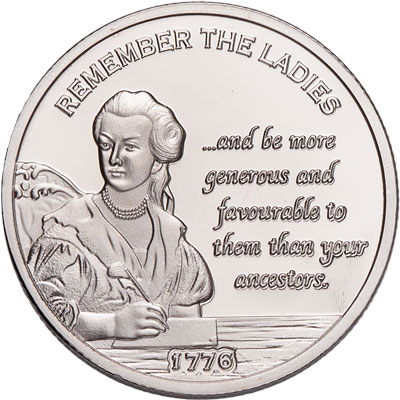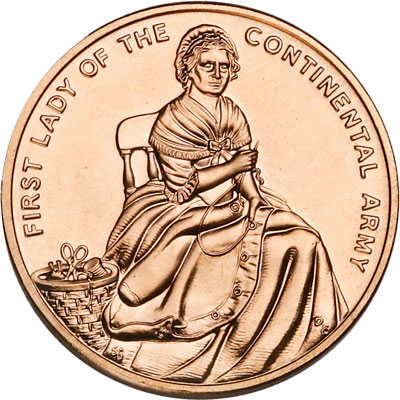Who were America’s first 3 First Ladies?
In the long march to American independence, men weren’t alone. There were women. Three became our new nation’s first First Ladies – none more outspoken than Abigail Adams. Her championing of women’s rights is why she’s honored on a 2025 half dollar as part of our exclusive America 250 series. All three wives were contemporaries. Come meet them!
March 31, 1776
It could be the most famous suffragist passage in American history – quite possibly the earliest known. In a letter dated the last day of March 1776, Abigail Adams wrote her lawyer-husband, John Adams, who was attending the Second Continental Congress in Philadelphia:
I long to hear that you have declared an independency. And, by the way, in the new code of laws which I suppose it will be necessary for you to make, I desire you would remember the ladies and be more generous and favorable to them than your ancestors.”
The Adamses shared a relationship of mutual respect, and by modern standards could be considered among the nation’s first power couples. Yet, they only lived together in Washington during the last four months of her husband’s single term as the country’s second president. Abigail ran the family farm in Quincy, MA, and raised their six children. Her early understanding of politics may have come from her grandfather, John Quincy, who served in the Massachusetts Bay Colony’s House of Representatives.
In near daily correspondence with her husband, Abigail was unafraid to voice her opinions on the affairs of the day. A lot of what we know about the early history of the United States comes from a lifetime of correspondence between them that Abigail saved.
In marked contrast, though, Martha Washington destroyed all her letters to her husband before she died. But there was another notable difference between Martha and Abigail.
The Revolutionary Martha
Sixteen years after they were married, George Washington was chosen as Commander in Chief of the Continental Army in 1775. The military campaigns would keep him away from his wife for six years. For at least five winter encampments during the War for Independence, George asked Martha to join him. Perhaps unimaginable today, but in the spirit of American independence, Martha Washington said yes.
George regarded Martha’s presence as so essential to the Revolutionary cause that he sought reimbursement from the Second Continental Congress for her traveling expenses. What was so essential? During these periods, Martha was his secretary. She also helped nurse his wounded troops. She mended their tattered uniforms. She hosted social activities to make the dreary winters more bearable. At least once, she was mistaken for a servant by soldiers who did not recognize her.
Martha, who was widowed when she married George, also encouraged a courtship involving another widow, Dolley Payne Todd of Philadelphia. The catch was rising political star James Madison, an architect of the U.S. Constitution, the subsequent co-writer of the Bill of Rights, and the scribe credited with drafting Washington’s first inaugural address. With three years to go in Washington’s second term, the couple married in 1794.
What did Dolley bring to the party?
When Thomas Jefferson was inaugurated as our nation’s third president in 1801, he appointed James Madison as his secretary of state. Married just six years at that point, James and Dolley Madison moved to the District of Columbia, struggling to be built on the clay soil and marshy lowlands of the Potomac River.
But a serious housing shortage existed. So, Jefferson invited the couple to live with him at the Executive Mansion. For a short time they called it home. Dolley occasionally was asked to help host the widowed president’s Friday receptions to which only one political party at a time was invited. After the couple established their own residence, Dolley’s skill as a hostess blossomed.
When James was inaugurated president in 1809 Dolley Madison moved with social confidence into the role of First Lady. She enjoyed her responsibilities. Nicknamed ‘squeezes’, her Wednesday night soirées were crowded, yet relaxed and fun, parties at which foreign visitors, members of Congress, Federalists, Republicans, plus noted luminaries mixed together.
Short-story writer Washington Irving described his arrival at one such reception as emerging:
from dirt and darkness into the blazing splendor of Mrs. Madison’s drawing room. Here I was most graciously received; found a crowded collection of great and little men, of ugly old women and beautiful young ones, and in ten minutes was hand and glove with half the people in the assemblage. Mrs. Madison is a fine, portly, buxom dame, who has a smile and a pleasant word for everybody.”
Her knack for hospitality set a standard for First Ladies to come. But Dolley also left another legacy. During the prolonged War of 1812, British troops invaded the capital city in 1814. By that point, James was already in command of troops confronting the British in Maryland. Dolley was left in charge of the Executive Mansion.
Thanks to her quick thinking and with the help of household staff, she saw to it that important Cabinet papers and one of Gilbert Stuart’s famous portraits of George Washington were relocated to safety. Shortly after Dolley and her entourage left for secure shelter in Leesburg, VA, the British arrived on the Executive Mansion and burned it to the ground.
Dolley died in 1849. At 81 years of age, she was one of only two* remaining spouses from the era of our nation’s “Founding Fathers” who bore witness to the birth of our nation – a feat we’re celebrating as America 250. In no small measure, Dolley, Abigail and Martha helped shape the United States’ early history. In addition to Abigail Adams, at least one other woman’s contribution is commemorated in our exclusive America 250 series. You can continue to collect – or start a collection! – into the anniversary year of 2026.
*Elizabeth Hamilton died in 1854.
SOURCES
George Washington’s Mount Vernon. “Ten Facts About Martha Washington”, accessed January 16, 2025, https://www.mountvernon.org/george-washington/martha-washington/ten-facts-about-martha-washington#:~:text=7
National Women’s History Museum. Howat, Kenna, Editor. “Dolley Madison, 2018.” Accessed January 23, 2025, https://www.womenshistory.org/education-resources/biographies/dolley-madison
Singleton, Esther. The Story of the White House. Volume One. (The McClure Company 1907) https://upload.wikimedia.org/wikipedia/commons/c/c7/The_story_of_the_White_House_%28IA_storyofwhitehous01sing%29.pdf
The New York Historical Society. “The First First Ladies” accessed January 20, 2025, https://www.nyhistory.org/meet-the-presidents/first-ladies







Beautiful choice of women to start it off start the collection off beautiful thank you enjoyed the articles sincerely Colleen Hill
Thanks for stopping by Colleen. We’re glad you enjoyed the article. Come back soon!